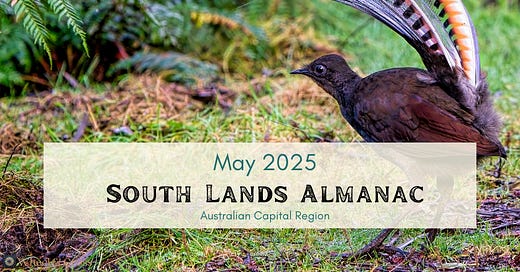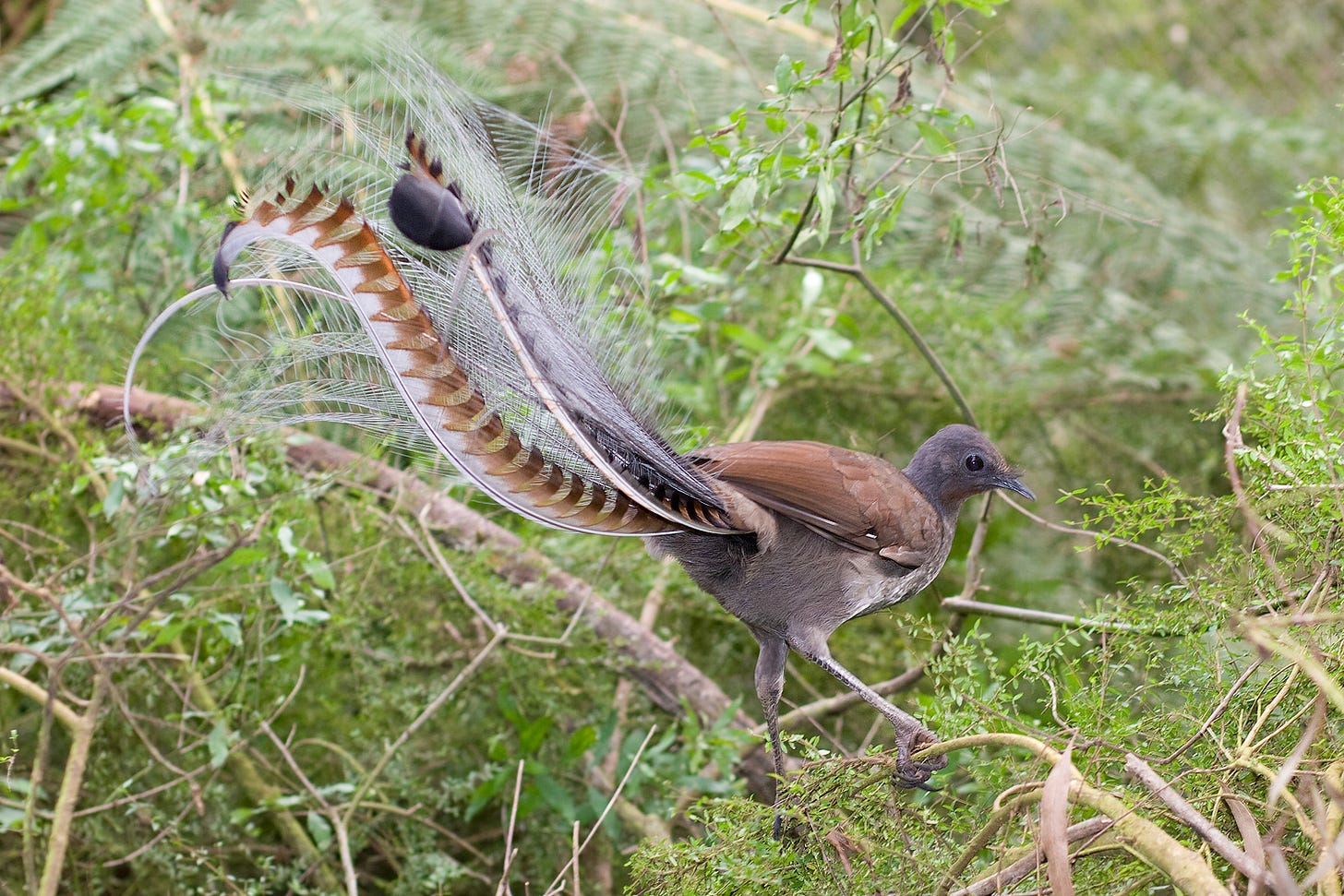South Lands Almanac - May 2025
Australian Capital Region
Wheel & Cross is proud to publish this monthly Almanac at the start of each month. It was created to observe and understand the cycle of seasons in the Australian Capital Region, through the lens of European agricultural knowledge and publicly available and openly shared knowledge of the traditional custodians of ‘Capital Country’, the Ngunnawal.
I acknowledge that the Ngambri people also claim custodianship of these lands. Unfortunately, I do not have any Ngambri cultural information regarding language, connection to Country or seasonal customs. This means I am unable to share anything relating to Ngambri culture but I am always keen to learn.
I pay my respects to all First Nations Elders, past and present and to all First Nations peoples from around Australia and the Torres Strait Islands who are the proud custodians of this Country we all love.
Contents
Important Dates in May
Ngunnawal Season - Magarawangga (Early Winter)
Weather and Climate
Weather Summary - April
Regional Water Storage - April
May and Winter Long-range forecast
Star Gazing and Star Lore
Moon phases - Hunter or Ancestor Moon
Visible planets, meteors and solar movements
Western and First Nations ‘star lore’ - Scorpius
Nature and Environment
Useful weeds - Rosehips
Native flora - Climbing Saltbush
Native fauna - Lyre Bird
In Season - seasonal crops, flowers and food
Important Dates
Source: Department of Home Affairs - Calendar of cultural and religious dates
1 May - Samhain (Australian seasonal celebration)
5 May - Star Wars Day (Global - Star Wars Film buffs)
5 May - Cinco de Mayo (Mexican)
12 May - Vesak or Buddha Day (Buddhist)
20 May - Dehwa Daymaneh (Mandean)
22-23 May - Declaration of the Báb (Baha’i)
26 May - National Sorry Day (Australian)
27-28 May - Ascension of Baha’u’lláh (Baha’i)
27 May - 3 June - National Reconciliation Week (Australian)
29 May - Ascension of Christ (Christian)
31 May - Dragon Boat Festival (Chinese)
31 May - Dano Festival (North and South Korea)
Samhain - 1 May

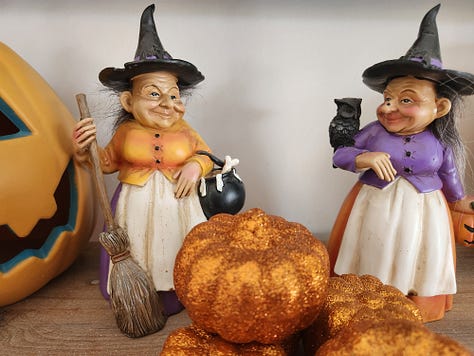

Samhain is a Gaelic word pronounced, sow-in or sa-wayne, originally called Samhainn in Scotland, and Shamhna in Ireland. It translates to summer's end and refers to the ancient Celtic festival marking the end of summer and the beginning of winter. Celebrations usually involved rituals, festivities, and customs centred around bonfires, divination and ancestor veneration.
With the spread of Christianity, pagan practices were discouraged, adapted or replaced by Christian celebrations. In 731 AD, Pope Gregory III designated November 1 as All Hallows Day to honour Christian saints and martyrs. In an attempt to integrate the widespread practice of ancestor veneration, All Souls Day on November 2 was dedicated to comforting the souls of those in purgatory as they await their final judgement. The night before All Hallows Day (October 31 in the northern hemisphere and April 30 in the southern hemisphere) became known as All Hallows Eve, which became Hallow’een and finally, Halloween.
The days between the end of summer and the start of winter were believed to be a liminal time, when the boundary between the world of the living and the Otherworld was thinnest, allowing ghosts, ancestor spirits, the fae (Tuatha de Dannan, Aos Sí/Aes Sidhe, the ‘people of the mounds,’ faeries or ‘The Good People’) and other supernatural beings to roam the earth.
To appease these spirits and protect themselves from harm, people would leave offerings of food and treats outside their homes. They would also go about in costumes, often wearing masks, with their clothes inside out and upside down, or cross-dressing in order to fool malevolent spirits into thinking they were spirits themselves. This evolved into trick-or-treating. The tradition of Jack-O-Lanterns evolved from the carving of turnips to carving pumpkins as Irish and Scottish immigrants brought their traditions to the Americas, where they first encountered pumpkins.
You can find out more about Samhain’s history and traditions in these Wheel & Cross episodes:
Episode 37 - Samhain Part 1: Bonfires, Divination and Ancestors
Episode 38 - Samhain Part 2: Trick or Treating, Games and Scares
Star Wars Day - 4 May
Star Wars Day, celebrated annually on May 4, is an informal holiday dedicated to the iconic Star Wars franchise, originating from the pun “May the Fourth be with you”. Fans worldwide mark the occasion with movie marathons, cosplay, themed events, and tributes to the galaxy far, far away.
Cinco de Mayo (Mexican) - 5 May
Cinco de Mayo marks the anniversary of the 1862 victory over invading French forces by Mexican troops at the Battle of Puebla. It is an important day for celebrating Mexican culture.
Vesak or Buddha Day (Buddhist) - 12 May
Vesak or Buddha Day is an important day of celebration for Buddhists around the world. The holiday is celebrated to commemorate the Buddha’s birth, enlightenment and death. The date varies each year as it is calculated through various regional lunar but is observed in many Asian countries and the United Nations on 12 May this year.
Dehwa Daymaneh (Mandean) - 20 May
Dehwa Daymaneh marks the Mandean celebration of the birthday of Yahya Yohana (John the Baptist). Mandaeism originated in Iran/Iraq and is a Gnostic, monotheistic, and ethnic religion with Greek, Iranian, and Jewish influences. Its adherents, the Mandaeans, revere figures like Adam, Seth, Noah, Shem, and especially John the Baptist. Unlike many religions, Mandaeism does not have practical guidelines but instead focuses on esoteric knowledge, including theology and the afterlife.
Declaration of the Báb (Baha’i) - 22-23 May
This date marks the anniversary of the Báb’s announcement of his mission in 1844. The Báb is considered to be one of the founders and a prophet of the Baha’i faith.
National Sorry Day (Australian) - 26 May
National Sorry Day acknowledges and raises awareness of the history and continued effects of the forced removal of Aboriginal and Torres Strait Islander people from their families, communities and culture.
Ascencion of Baha’u’lláh (Baha’i) - 27-28 May
Ascension of Baha’u’lláh commemorates the anniversary of the death in 1892 of Baha'u'lláh, the founder of the Baha'i faith. This solemn anniversary is a day of rest and is often observed by reading or chanting from the scriptures. Many pilgrims visit Baha'i shrines and tomb in Israel to pray.
National Reconciliation Week (Australian) - 27 May - 3 June
National Reconciliation Week celebrates and builds on the respectful relationships shared by Aboriginal and Torres Strait Islander people and other Australians.
Ascension of Christ (Christian) - 29 May
The Ascension of Christ is a Christian holiday commemorating Jesus Christ's ascension into heaven.
Dragon Boat Festival (Chinese) - 31 May
Dragon Boat Festival (Duanwu Jie or Double Fifth Festival) commemorates the death of the Chinese poet Qu Yuan. It is celebrated in China, Taiwan, Malaysia, Singapore and parts of Indonesia. Cultural events involve eating rice dumplings and traditional dragon boat racing.
Dano Festival (North and South Korea) - 31 May
Dano is an official holiday in both North and South Korea to celebrate the end of spring as the summer season is welcomed. The day marks the beginning of the growing season when the farmers have finished seeding and planting, and the Yang energy is at its highest.
Ngunnawal Season - Magarawangga (Early Winter)
Sources: Tyronne Bell, Ngunnawal Elder, Thunderstone Cultural Aboriginal Services
The Australian Capital Region is part of the Southern Tablelands. It has a cool temperate climate featuring warm to hot and dry summers and cold winters with heavy frosts and radiation fog.
May marks the second month of the Ngunnawal season of Magarawangga - early winter. During this month, Kurrajong seed pods are drying, and the seeds are ready for harvesting, roasting and grinding into flour. Saltbush berries are ripe and ready to eat, and the Superb Lyrebird is breeding. Listen for its beautiful song in forested areas.
Weather and Climate
Sources: Australian Bureau of Meteorology, WeatherZone.com.au, Timeanddate.com, Weather Spark, Weather Atlas
Under the Köppen climate classification system, Canberra’s climate is classified as Cfb, denoting a temperate oceanic climate characterised by warm summers, moderate winters and minimal rainfall differences between seasons.
Weather Summary - April
April days and nights were warmer than average for most of Australia and rainfall remained below average for much of the Australian Capital Region.
Soil moisture remained average through most of the Australian Capital Region except for areas in the north and west, which experienced below-average soil moisture.
Max Temp - The average maximum temperature for April this year was 23.5°C, higher (2.7°C) than the long-term average of 20.8°C. The highest maximum temperature was 28.4°C recorded on 11 April.
Min Temp - The average minimum temperature for April this year was 7.2°C, on par (0.4°C) with the long-term average of 6.8°C. The lowest minimum temperature for the month was -0.1°C recorded on 6 April.
Rainfall - It rained over 1mm on 4 days in April with 2 days receiving less than 1mm for a total of 32.2mm, substantially less than the April average of 7.5 days and 42.8mm of rain. The highest amount fell on 30 April with 15mm of rain.
Water Storage - April
Water storage levels are mixed across the Murray Darling Basin, which remains unaffected by the heavy rain and flooding from recent weather events in the north.
Water for the Australian Capital Territory and Queanbeyan in NSW is stored in four dams across two water catchments, managed by Icon Water. These include Corin, Bendora, Cotter and Googong. Storage levels in Canberra are at 89.2% (247,893 ML of 277,839 ML) according to the Bureau of Meteorology.
Queanbeyan Palerang Regional Council has an agreement with Icon Water to purchase potable water for the Queanbeyan area. The villages of Braidwood, Bungendore, and Captains Flat have their own water treatment facilities for bore water, which service the urban area of the three towns/villages. Bungendore has reached its water sustaining capacity and options for a pipeline from Queanbeyan are currently being explored.
Goulburn Mullwaree Council supplies water to Tarago and Lake Bathurst from the Pejar Dam (9,000ML), Sooley Dam (6,250ML), and Rossi Weir (330ML) via the Goulburn Water Filtration Plant, and the Highland Source Pipeline.
The Upper Lachlan Shire Council manages water supply to Gunning via pumping from the Lachlan River into a storage dam (100ML) then into town through a water treatment facility. No information is available on storage levels. Collector relies on untreated water from roof-top rain collection and local bores.
Water for the Yass Valley Council region including the town of Yass, and villages of Bowning, Binalong and Murrumbateman is supplied from the Yass Dam (2,460ML and 15,000 pax capacity). It is currently sitting at 87.3% capacity. Gundaroo relies on untreated water supplies from roof-top rain collection and local bores.
May Weather Forecast
Australian Bureau of Meteorology
Generally speaking, May's weather continues to cool with the average high temperature dropping to 16.5°C and the average low dropping to 2.4°C. Frosts and fogs are common. May traditionally has the least amount of rain for the year. Rain over 1mm falls for an average of 3.9 days with 33.4mm of accumulated precipitation.
Current weather forecasts predict continuing warmer-than-average days and nights with an increased chance of unusually high temperatures. Rainfall is expected to be below average for most of the region.
Seas Surface Temperatures (SST) around Australia continue to experience extremely warm anomalies around Australia are expected to remain higher than average. The El Nino Southern Oscillation is forecast to stay neutral.
Long-range Forecast
The Australian Bureau of Meteorology has released its long-range forecast for May to July 2025.
Star Gazing and Star Lore
Sources: Time and Date, SciTech, Australian Indigenous Astronomy,
Lunar Phases
Sunday, 4th - First Quarter Moon (waxing) - Rise 1:09 pm ENE, Set 11:23 pm WNW
Tuesday, 13th - FULL MOON* (Hunter or Ancestor Moon)** - Rise 5:07 pm ESE, Set 8:13 am WSW (14th)
Tuesday, 20th - Last Quarter Moon (waning) - Rise 11:43 pm ESE, Set 1:16 pm WSW (21st)
Wednesday, 28th - New Moon - Rise 7:00 am ENE, Set :5:22 pm WNW
**The names of the full moons provided here generally correspond with names used in old English agricultural calendars and similar American Almanacs, although they have been rearranged according to their appropriate season in the southern hemisphere. See Full Moon Names for the Southern Hemisphere for more information.
Stars, Planets and Meteors
Not all stars in the night sky are scientifically stars. True stars comprise the vast number of what we call ‘stars’. They appear to twinkle as their light comes from active suns in distant solar systems. The other celestial bodies we call ‘stars’ are planets in our solar system visible from Earth. They shine steadily in the night sky rather than twinkle as they steadily reflect the sun’s light, rather than producing their own light.
MERCURY - is visible below Venus, just above the eastern horizon before dawn until it gets lost in the glare of the Sun near the end of the month.
VENUS - the ‘Morning Star’ is particularly bright in the eastern sky just before dawn.
MARS - is visible in the north-northwest sky and can be seen next to the First Quarter Moon on May 4.
JUPITER - is visible in the northwest for an hour or so after sunset. It will disappear behind the sun by the end of the month and reappear in the eastern sky before sunrise in early July.
SATURN - is visible with a telescope in the eastern sky before dawn, sitting slightly higher than Venus.
METEORS - The Eta Aquarids meteor shower begins and lasts all month, peaking on 5 May. They are fast moving and vibrant meteors whose bright streaks originate from Halley’s Comet.* The best time to see the meteor shower is in the east before sunrise on most days of this month but particularly from the 4th to the 6th of May.
*A comet is a celestial body made of ice, dust, and rock that orbits the Sun. When they get close to the Sun, melting ice causes dirt and pebbles to ‘outgas’, forming a tail. Pieces of pebble and dirt from the outgassing comet, collide with our atmosphere causing meteor showers.
Halley's Comet, first recorded by Chinese astronomers in 240 BCE, was later identified by Edmond Halley in 1705 as a periodic comet returning approximately every 76 years. It has been observed throughout history, inspiring artwork, scientific discoveries, and even appearing in the Bayeux Tapestry following the Norman Conquest of England in 1066.
Constellation Feature - Scorpius

In the southern hemisphere, the constellation of Scorpius becomes visible at the end of April, rising low on the eastern horizon after sunset. It lies across the Milky Way with the bright star, Antares - a red supergiant star, 9,000 times brighter than our Sun - visible in the centre of Scorpius’ head. Scorpius will rise through the winter months before sinking below the horizon during summer.
Ancient Babylonians knew the constellation as Mulgirtab (the ‘Scorpion’), while the name Scorpius was used by Ancient Greeks, both of whom depicted Scorpius with two enormous claws. Around 100 BC the Ancient Romans cleaved the claws off of Scorpius to form the constellation of Libra ‘scales of justice,’ reducing the size of Scorpius.
There are several ancient Greek myths about Scorpius, often associated with Orion. In one version, Orion boasted about his hunting prowess to the goddesses Artemis and Leto (Artemis’ mother) and bragged that he would kill every animal on earth. The two goddesses were horrified and sent a scorpion to kill Orion. Orion and the Scorpion fought and killed each other. Zeus raised both Orion and the scorpion at opposite ends of the sky as reminder for mortals to curb their excessive pride.
In another version, Orion tried to earn the favour of Artemis by saying she was better than her twin brother Apollo. In retribution for the insult, Apollo sent a giant Scorpion to kill Orion. There was a great battle and they killed each other. Artemis, saddened by Orion’s death, asked Zeus to raise Orion to the sky. This Zeus did but he also raised the Scorpion to the sky. Now, every summer Orion hunts in the sky but flees when the Scorpion comes in the winter.
Australian First Nations have their own mythologies about the constellation Scorpius, many align with geological patterns found on Country, like this story known by the Kamilaroi and Euahlayi people of north west NSW:
The constellation Scorpius, which crosses the Milky Way, and looks like a scorpion, is known by the Kamilaroi and Euahlayi not so much for the star pattern, as for the dark spaces around it. While it is very difficult to see them, there are two or three dust patches in the vicinity of the tail and the claws, which someone with very good eyes and a dark sky might see. These are actually holes which the spirit of the whirlwind, Wilbaarr, uses to come to Earth in September, when whirlwinds are common.
These whirlwinds which Australians call “willy willys” (from the Euahlayi warrawilbaarru for the same spirit) commonly come to northwest New South Wales in September. The story is that Wilbaarr has a reputation for madness and stealing souls. Baiame calls him back, but can’t stop him coming to Earth, as he can come through any of the dark spots. September is also the time the sacred fire is lit, and young men travel, so Wilbaarr tries to catch them.
Because “everything up there is down here”, the three dark spots in Scorpius have their equivalent in the Narran and Barwon Rivers country. There are three depressions in the ground, called Buuliis, which are located in a pattern very similar to that of Scorpius, overhead. The word Buulii also means “whirlwind” in Euahlayi.
Star Stories of the Dreaming: Astronomy of the Kamilaroi and Euahlayi Peoples and their neighbours - A Study Guide for K-10 students, Aboriginal Astronomy
The Yolgnu people of east Arnhem Land associate the constellation with both a crocodile and a scorpion. The crocodile’s appearance high in the midwinter skies in July, indicates the imminent arrival of the Macassan traders from the Indonesian island of Sulawesi. It also represents the scorpion Bundungu and his people, gathered along the banks of the Milnguya (Milky Way) with their relatives, the Wahk (crow) and the Baripari (Quoll).
The Wiradjuri and related language groups of central New South Wales, depict the constellation, including the bright star of Antares, as Guggaa, the tree goanna. When Guggaa rises completely above the horizon at dusk in July and August, he is seen to be climbing up his celestial tree. As he is still lean and thin from lack of food over winter, it is considered the wrong time of year to hunt goanna. In October and November, Guggaa faces downwards, indicating that he is now fat from feasting on the eggs and chicks of nesting birds over spring. This is now a good time to hunt goanna who is full of nutritious fat, an important source of food and medicine.

Other Constellations
Southern Cross (Crux) - rising in the sky moving downwards to its south west side from its formerly upright position. More information in the January issue.
Sky Emu (Milky Way) - rising upright on the diagonal, its full length appears after sunset from the South stretching to the southeast. At this time it looks like a running emu, indicating the start of the breeding season when female emus pursue the males and start laying eggs. This in turn indicates to many First people that it’s the start of the egg-collecting season. More information in the April issue.
Twins (Gemini) - no longer visible in the night sky by the end of May until the start of summer. More information in the December 2024 issue.
Dog Star (Sirius) and Great Dog (Manis Major) - no longer visible in the night sky by the end of May until the start of summer. More information in the February issue.
Warrior (Orion) - no longer visible in the night sky by the end of May until the start of summer.
Bull (Taurus) - no longer visible in the night sky by the end of May until the start of summer. More information in the March issue.
Seven Sisters (Pleiades) - no longer visible in the night sky by the end of May before appearing again in the early mornings in late June.
Centaurus - high in the southern sky, wrapped around the Southern Cross.
Scorpius - rising low on the eastern horizon at sunset.
Sagittarius and Corona Australis - rising low on the eastern horizon at sunset.
Aquila - rising low on the eastern horizon at sunset.
Southern Fish (Piscis Austrinus) - not visible until its reappearance in July.
Nature and the Environment
Most of the information provided about native seasonal flora and fauna is relevant to the cool climate region in Australia’s south, particularly the Australian Capital Region, and can be found in the book, ‘Ngunnawal Plant Use: A Traditional Aboriginal Plant Use Guide for the ACT region,’ and the ‘Ngunnawal Seasonal Calendar’ by Ngunawal Elder and traditional custodian, Tyronne Bell from Thunderstone Aboriginal Cultural Services.
Useful Weeds (Food/Medicine)
Rosehips
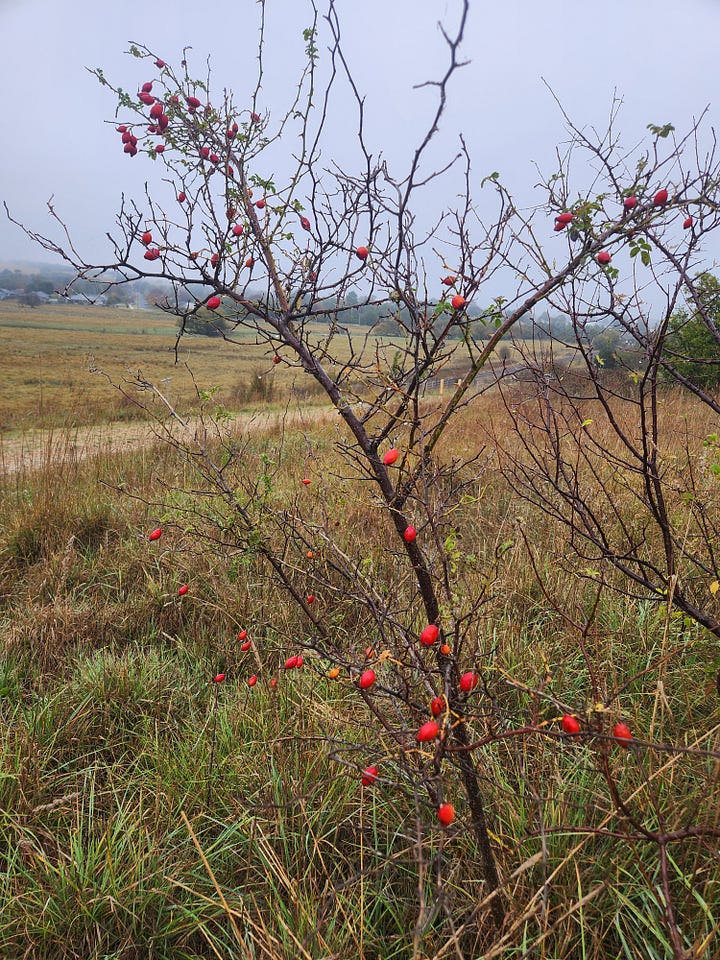

The dog rose (Rosa canina) and briar rose or sweet briar (Rosa rubiginosa) are scrambling, prickly shrubs native to Europe and Asia, introduced to Australia as ornamental plant and rootstocks for cultivated roses. Over time, they naturalised in southern and eastern Australia, thriving in pastures, bushland, roadsides, and riparian habitats. They form dense thickets that hinder movement, reduce land productivity, and restrict stock access to water, making them a problematic weed. Additionally, their allelopathic seeds can inhibit germination of other species, while their thorny growth provide shelter for pest species like rabbits. Their invasiveness requires landholders to employ control methods including manual removal, herbicides, and land management strategies. See the Weeds Australia ‘Dog Rose’ and ‘Sweet Briar Rose’ profiles for more information.
Dog and briar roses produce rosehips in Autumn that are packed with vitamin C, making them a powerful immune booster that helps fight colds and infections. They also contain antioxidants like vitamin E and flavonoids, which support skin health, reduce inflammation, and promote wound healing. Studies suggest that rosehip extracts can ease joint pain and stiffness, making them beneficial for arthritis sufferers. Additionally, their high fibre content aids digestion, while their cardiovascular benefits include lowering cholesterol and reducing blood pressure. They can be consumed fresh or dry as a tea, or processed to produce rosehip oil for topical treatments.
Rosehips are naturally rich in pectin, a key ingredient that helps jam set and thicken. However, they contain tiny, stinging hairs inside their seeds, which can cause irritation to the throat and digestive tract if consumed without proper preparation such as straining the liquids or oils through a fine sieve.
Native Flora
Climbing Saltbush (Chenopodium/Einadia/Rhagodia nutans) - Tiny red berries of Climbing Saltbush are ripe. Its fruit are sweet and edible, though too small to provide much sustenance to humans. However, they are an important food source for native birds and lizards.

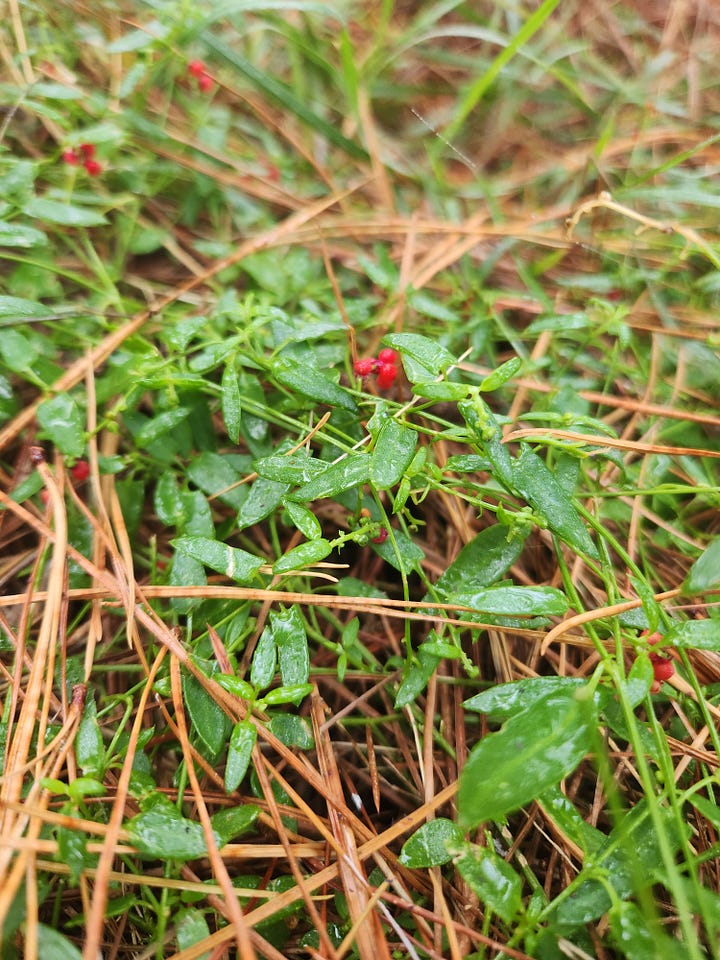
Native Fauna
Superb Lyrebird (Menura novaehollandiae) - The superb lyrebird (Menura novaehollandiae) is a fascinating ground-dwelling bird, native to Australia. It is distributed across south-eastern Australia, including Victoria, the ACT and New South Wales, as well as Tasmania, where it was introduced. These birds thrive in dense forests and rainforests, often preferring areas with rich undergrowth that provide ample cover and food sources.
One of the most defining features of the superb lyrebird is its extraordinary ability to mimic sounds. It can replicate the songs of other birds, as well as human-made noises like chainsaws, camera shutters, and car alarms, with remarkable accuracy. The males are especially renowned for their intricate and dramatic courtship displays, during which they spread their strikingly beautiful tail feathers, shaped like a lyre, and perform complex vocalizations to attract mates. Their breeding season runs from April to October.
In Season
Cut Flowers
Sources: Meadow and Widler Farm, What Cut Flower is That
Flowers finishing this month: Ageratum (Ageratum spp.), Amaranth (Amaranthus spp.), Babies Breath (Gypsophila paniculata), Belladonna Lily (Amarylis belladonna), Bells of Ireland (Molucella laevis), Calendula (Calendula officinalis), Chrysanthemum (Chrysanthemum spp.), Cock’s Comb (Celosia spp.), Cosmos (Cosmos bipinnatus spp.), Dahlias (Dahlia hybrids), Echinacea (Echinacea purpurea), Guernsey Lily (Nerine spp.), Hollyhocks (Alcea and Alcathaea spp.), Lisianthus (Eustoma spp.), Peruvian Lily (Alstroemeria aurantiaca), Pincushion (Scabiosa caucasica), Statice (Limonium spp.), Sunflower (Helianthus annus)
Flowers starting this month: None
Flowers continuing this month: Heath (Erica spp.), Lavender - French (Lavendar dentata), Snapdragon (Antirrhinum majus).
Kitchen Garden
Source: Food Tree, Sustainable Table
Herbs - Basil, chervil, chilli, chives, coriander, dill, garlic, ginger, lemongrass, mint, oregano, parsley, rosemary, sage, tarragon, thyme
Vegetables - Artichokes, Asian greens (bok choy, choy sum, gai laan, wombok) avocado, beans (borlotti, butter, green), beetroot, broccoli, brussels sprouts, cabbage, capsicum, carrot, cauliflower, celery, corn, cucumber, daikon, eggplant, fennel, leek, lettuce, mushrooms, okra, onion, parsnip, potato, pumpkin, shallot, silverbeet, spinach, spring onion, squash, swede, sweet, potato, tomato, turnip, watercress, witlof, zucchini
Fruit - Blackberries are now ‘blighted’ by frosts and inedible. Autumn-bearing raspberries are tapering off. Stone fruit have finished their season. The Autumn apple harvests are in glut (aba, bonza, braeburn, cox’s orange pippins, fuji, gala, golden delicious, granny smith, jonagold, jonathan, mutso, pink lady, red delicious, snow, sundowner). The pear harvest is also in glut (beurre bosc, howell, josephine, packham, red sensation, williams). Persimmon, pomegranate and fig are tapering off and will be done by the end of the month. Table grapes (white, red and black) continue their harvest season. Navel and Valencia oranges, imperial mandarins and limes are in season. Feijoa, kiwi fruit and rhubarb are in season.
Mushrooms - mushroom season is ramping up. Be careful while foraging. See the April edition for more information.
If you’d like to know what to plant in the kitchen garden this month, the Canberra Organic Growers Society (COGS) website has a useful Autumn Planting Guide for our region.


